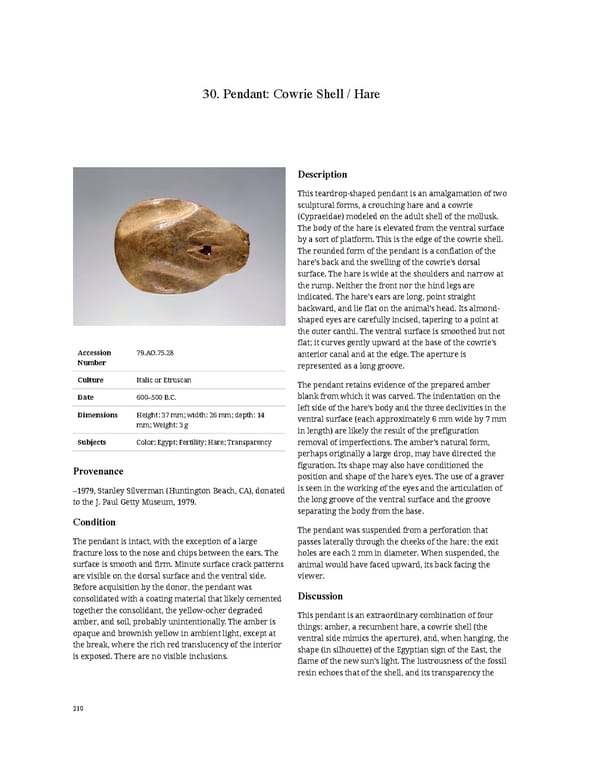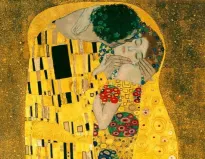30. Pendant: Cowrie Shell / Hare Description This teardrop-shaped pendant is an amalgamation of two sculptural forms, a crouching hare and a cowrie (Cypraeidae) modeled on the adult shell of the mollusk. The body of the hare is elevated from the ventral surface by a sort of platform. This is the edge of the cowrie shell. The rounded form of the pendant is a conflation of the hare’s back and the swelling of the cowrie’s dorsal surface. The hare is wide at the shoulders and narrow at the rump. Neither the front nor the hind legs are indicated. The hare’s ears are long, point straight backward, and lie flat on the animal’s head. Its almond- shaped eyes are carefully incised, tapering to a point at the outer canthi. The ventral surface is smoothed but not flat; it curves gently upward at the base of the cowrie’s Accession 79.AO.75.28 anterior canal and at the edge. The aperture is Number represented as a long groove. Culture Italic or Etruscan The pendant retains evidence of the prepared amber Date 600–500 B.C. blank from which it was carved. The indentation on the left side of the hare’s body and the three declivities in the Dimensions Height: 37 mm; width: 26 mm; depth: 14 ventral surface (each approximately 6 mm wide by 7 mm mm; Weight: 3 g in length) are likely the result of the prefiguration Subjects Color; Egypt; Fertility; Hare; Transparency removal of imperfections. The amber’s natural form, perhaps originally a large drop, may have directed the Provenance figuration. Its shape may also have conditioned the position and shape of the hare’s eyes. The use of a graver –1979, Stanley Silverman (Huntington Beach, CA), donated is seen in the working of the eyes and the articulation of to the J. Paul Getty Museum, 1979. the long groove of the ventral surface and the groove Condition separating the body from the base. The pendant was suspended from a perforation that The pendant is intact, with the exception of a large passes laterally through the cheeks of the hare; the exit fracture loss to the nose and chips between the ears. The holes are each 2 mm in diameter. When suspended, the surface is smooth and firm. Minute surface crack patterns animal would have faced upward, its back facing the are visible on the dorsal surface and the ventral side. viewer. Before acquisition by the donor, the pendant was Discussion consolidated with a coating material that likely cemented together the consolidant, the yellow-ocher degraded This pendant is an extraordinary combination of four amber, and soil, probably unintentionally. The amber is things: amber, a recumbent hare, a cowrie shell (the opaque and brownish yellow in ambient light, except at ventral side mimics the aperture), and, when hanging, the the break, where the rich red translucency of the interior shape (in silhouette) of the Egyptian sign of the East, the is exposed. There are no visible inclusions. flame of the new sun’s light. The lustrousness of the fossil resin echoes that of the shell, and its transparency the 210
 Ancient Carved Ambers in the J. Paul Getty Museum Page 219 Page 221
Ancient Carved Ambers in the J. Paul Getty Museum Page 219 Page 221
